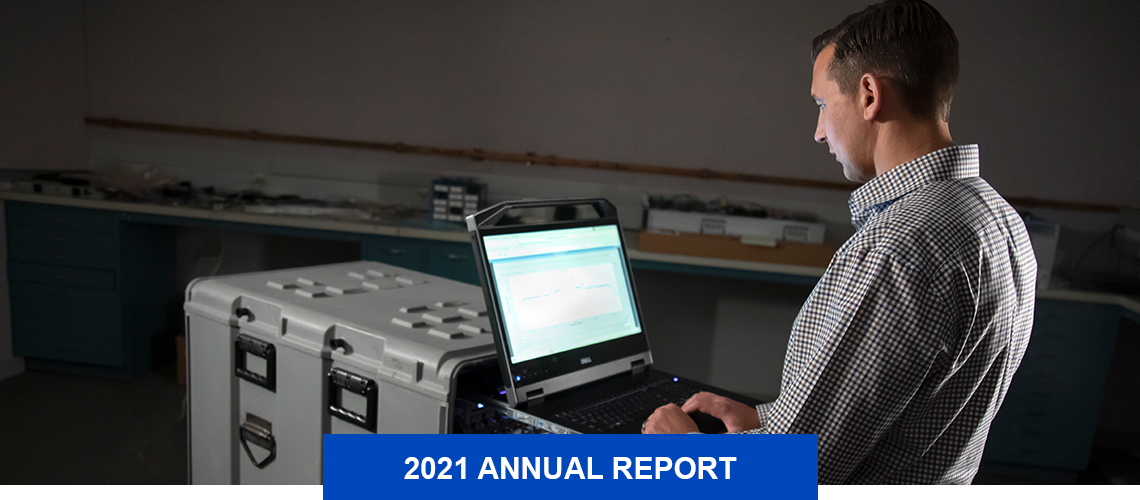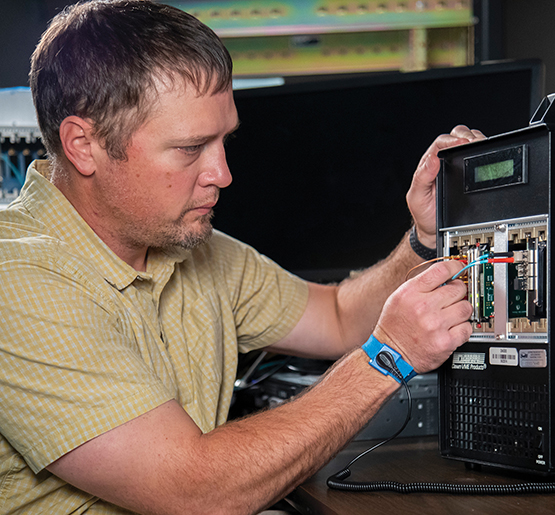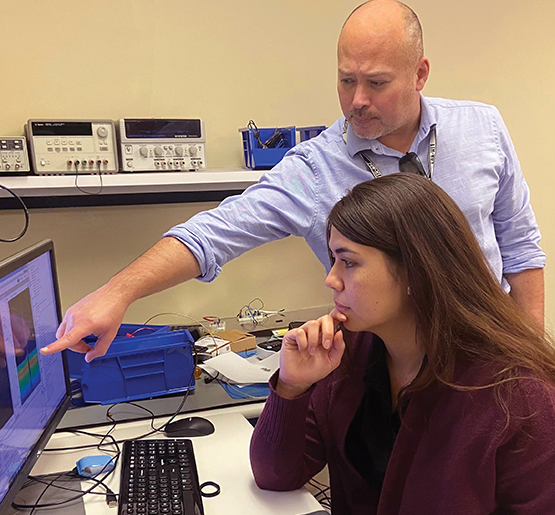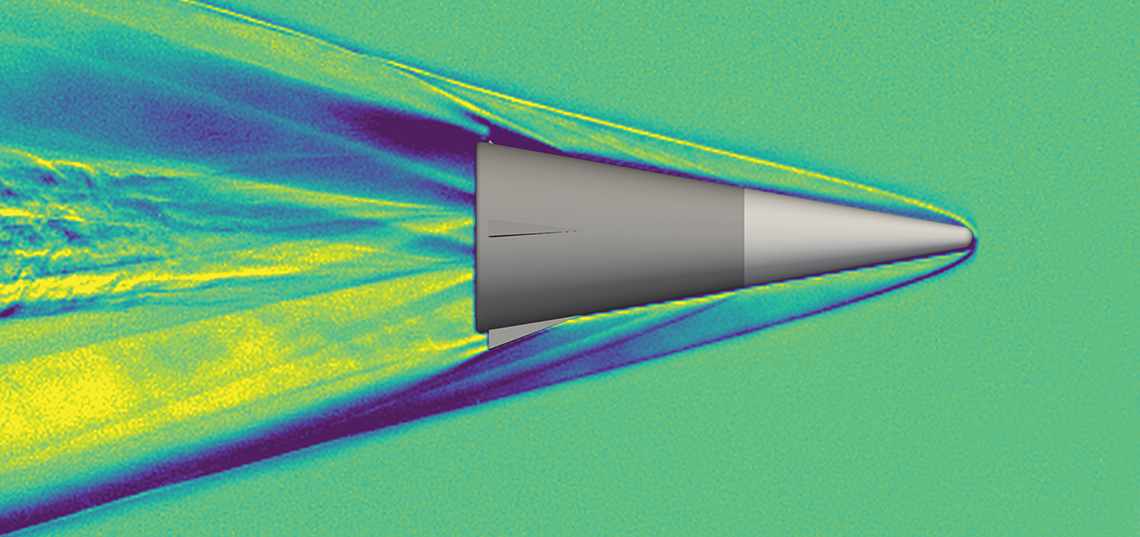
About the Header
A new software defined radio design advances a common application interface for multiple intelligence-gathering tools used during military missions.
From shoring up the nation’s electronic warfare (EW) and cybersecurity defenses to developing secure networks for remote work and learning, SwRI is on the front lines of communications intelligence (COMINT), signals intelligence (SIGINT), electronic intelligence (ELINT) and software solutions for government and industry clients. SwRI builds high-performance data infrastructure and creates technology, tools and techniques to disrupt, intercept and detect a range of signals on the electromagnetic spectrum, supporting efforts to thwart adversaries.
DEFENSE
SwRI continues to expand geolocation and network development to support the U.S. government as well as clients abroad. With a solid foundation developing coordinated worldwide geolocation networks, we developed new software capabilities and used various algorithmic techniques and control methods to provide interoperability and collaboration of existing networks and sensors for geolocation operations. With an emphasis on developing intelligence community message and interface standards, our focus is improving mission capabilities, while reducing client costs.
SwRI designed, developed and demonstrated a multichannel, software-defined radio (SDR) prototype to perform simultaneous COMINT, ELINT and electronic attack and cyber operations for the U.S. military. The prototype relies on a new microservices software architecture that accelerates the development of SDR functions and hosts existing SDR applications.

SwRI demonstrated a miniaturized system for detecting and characterizing tactical frequency-hopped radios that provide real-time situational awareness on the battlefield. This capability is targeted for deployment on mobile platforms such as aircraft and ships.

Our engineers are developing the modular, government-owned Ravager electronic warfare system designed to maximize operational effectiveness and flexibility, while improving the sustainability of fighter aircraft EW systems
In 2021, SwRI conducted environmental and electromagnetic interference and compatibility testing of A-10 central interface control units, designed to replace legacy systems and modernize aging aircraft.
Using sensor open system architecture and commercial off-the-shelf products, SwRI is further developing the Ravager Electronic Warfare System, an advanced and highly adaptable modular system that allows rapid technology updates and improves interoperability with existing and future military systems. Ravager addresses supplier and parts shortages, while extending the life of existing technologies. Using internal funding, our engineers continue to discover adaptive EW technologies to integrate into Ravager.
SwRI’s powerful Ultra-Wideband Receiver (UWR) technology, another sensor open system architecture developed with internal funding, allows EW systems to review a wide range of the radar spectrum at once, instead of slowly scanning it. The approach cost-effectively yields fast detection of all radar types. SwRI is developing the UWR technology, supported by a high-speed, high-performance interoperable system.
In 2021, the U.S. Air Force implemented SwRI’s Adaptive Threat Environment Acquisition (ATHENA) technology, an advanced ELINT receiver, on multiple systems. High-resolution measurements, instantaneous broad bandwidth and added detection capabilities set ATHENA apart from other ELINT systems. Using internal funding, SwRI designed ATHENA to identify current and future threats, making it a long-term intelligence solution for the Air Force.
This year, SwRI developed a Low Probability of Intercept (LPI)/Low Probability of Detection (LPD) high-frequency communications subsystem, which uses a new waveform. The waveform operates at ultra-low power levels making it difficult for adversaries to detect, while randomized bandwidth and baud rate, or information transfer speed, obscures its characteristics. As a complementary capability, SwRI developed new techniques to detect and characterize multiple, simultaneous LPI/LPD waveforms of interest. SwRI successfully demonstrated its LPI/LPD detection techniques deployed on a U.S. government-operated unmanned aerial vehicle.

Fire technologists performed flame propagation tests to assess the performance of different coating configurations for cables used in nuclear submarines.

In 2021, SwRI conducted environmental and electromagnetic interference and compatibility testing of A-10 central interface control units, designed to replace legacy systems and modernize aging aircraft.

Pharmaceutical researchers continue to develop antidotes for chemical warfare agents, particularly neurotoxins that attack the central nervous system. In 2021, chemists scaled up pilot plant production of a countermeasure for a class of nerve agents.
SwRI is expanding radio frequency and signal analysis capabilities and facilities, completing a new antenna testing facility in 2021. A new anechoic chamber will be completed in 2022, allowing broader data collection of antenna patterns, including frequencies, elevation angles and polarizations. A three-story building addition, slated for completion in early 2023, will house new laboratory and office space.
SwRI is discovering and delivering system solutions for national security and business applications, expanding our reach in signals intelligence, electronic warfare systems and aerospace and defense software design. Looking ahead, we are focused on creating products and tools that offer connection, interoperability and adaptability for increased productivity and long-term utility.
Harnessing hypersonic flight capabilities at speeds five times the speed of sound, or in excess of Mach 5, is important to national security. It could also revolutionize the air travel industry. In response, SwRI advanced higher-temperature capabilities to understand material deformation and failure associated with the extreme heat — with temperatures up to 5,500 degrees Fahrenheit — that hypersonic flight bodies experience. Using our large two-stage light-gas gun, we conducted the first flyer plate impact tests at elevated temperatures, accomplished using a laser to preheat the target in a vacuum chamber. Engineers are using “free flight” techniques to obtain aerodynamic data free of support interference and exhibiting more realistic flows around various flight bodies. These tests are supporting advanced optical and spectral diagnostics. Engineers performed plate impact tests to understand the high-pressure, high-speed nonlinear response of carbon-carbon thermal protection materials. The teams are looking at techniques to improve the manufacture of carbon-carbon materials and are developing computational and design tools for hypersonic scramjets.

Using SwRI’s two-stage light-gas gun to simulate hypersonic flight, engineers study the shock wave velocities around the flight body, using techniques including the false-color schlieren image shown here.
SECURITY
In 2021, SwRI received several contracts to support work in developing autonomous and robotic military vehicles. In addition, we developed intrusion detection systems to help secure military as well as commercial ground vehicles from cyberattacks via embedded systems and connected vehicle networks.
SwRI is helping address cybersecurity concerns associated with intelligent transportation systems, developing strategies to balance digital asset protection and cybersecurity risk with data and information sharing that supports increasingly data-driven operations. We are working with national, state and law enforcement agencies to develop a framework for communication and information sharing between transportation roadway stakeholders when detecting and responding to a cyberattack or vulnerability issue that spans across multiple devices or other industries.
